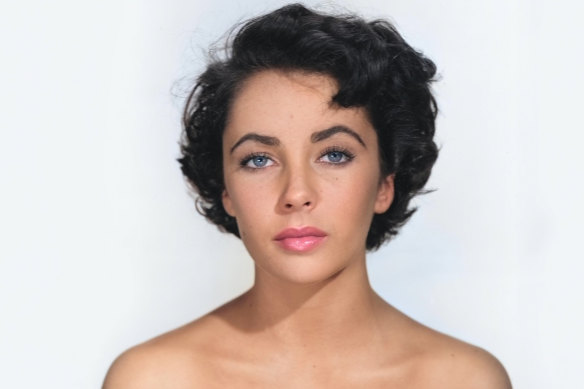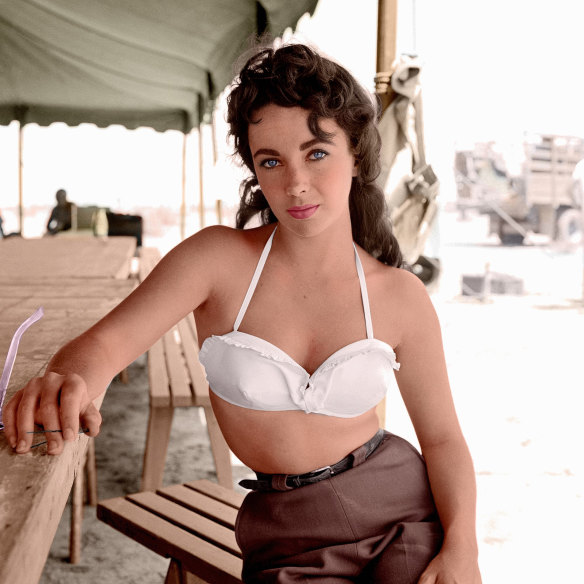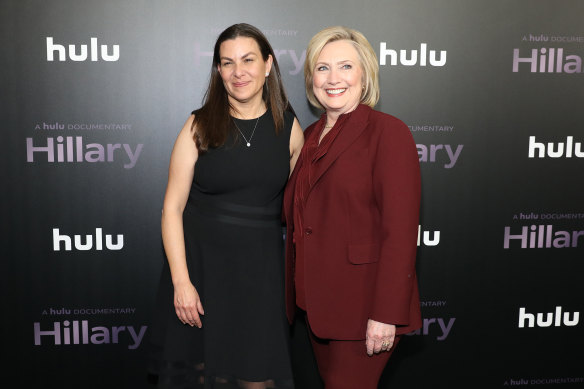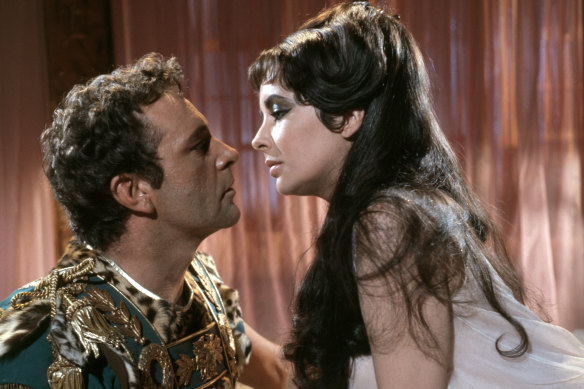This was published 10 months ago
Lost tapes reveal Elizabeth Taylor’s struggle with fame and shame
Long-lost audio interviews with the double Oscar winner reveal her life-long struggle with fame, and the cause that became her crowning glory.
By Karl Quinn

Elizabeth Taylor won two Oscars, was married eight times, and became a major AIDS activist.
Long before she turned her documentary skills upon her, Nanette Burstein was a fan of Elizabeth Taylor as an actress.
“The first movie of hers I saw was Who’s Afraid of Virginia Woolf?, and I thought it was an extremely daring and brilliant performance,” says Burstein, whose past subjects have included amateur boxers (On The Ropes), Hollywood producer Bob Evans (The Kid Stays in the Picture) and former US first lady and presidential candidate Hillary Clinton (Hillary).
But it wasn’t until she began working on Elizabeth Taylor: The Lost Tapes that she began to understand how the English-born former child actor inadvertently paved the way for some of the less salutary aspects of modern popular culture.

Elizabeth Taylor on the set of Giant in 1955.Credit: Frank Worth
“I never quite put two and two together that she was one of the first modern celebrities, that she almost invented the definition of paparazzi that a Princess Diana or a Taylor Swift had to deal with, and how do you manoeuvre that, how do you actually use that as a vehicle for good,” Burstein says.
Burstein’s deeper engagement with the double Oscar winner began in 2021 when she was approached about training her storytelling skills on a treasure trove of audio that had come to light just a few years earlier.
Recorded on reel-to-reel tape by journalist Richard Meryman in 1964, the 40 or so hours of interviews were recorded for a book ghostwritten by him and published that year as the autobiography Elizabeth Taylor. For decades after, they sat in a box in the attic of the Meryman home until, around 2019, they were unearthed and passed on to Taylor’s heirs.
“They were put on a private plane and seatbelted in a box, and the Taylor estate said, ‘We should try to make a movie with this; what a great way to show who the real Elizabeth is’,” Burstein explains.
“I listened to all the tapes, I had them transcribed and made selects, and I wrote a treatment of what I thought it would be, which wasn’t far off from what it ended up being. But I didn’t start making the film in earnest until a year ago. These things can take a while to percolate before you actually start making them.”
Burstein was speaking at the Cannes Film Festival, where the documentary had its world premiere in May. She was already at work on her next, a biography of the late astronomer and planetary physicist Carl Sagan. Clearly, she likes her subjects big.

Nanette Burstein’s previous subjects include Hillary Clinton.Credit: Monica Schipper
And movie stars don’t come much bigger than Taylor. Cast in her first movie as a nine-year-old, by her mid-teens she was being openly touted as a sex symbol. A clip from a newsreel in Burstein’s film has the narrator droolingly introduce her as “just about the best looking 15-year-old girl known to the public at large”.
It makes for uncomfortable viewing, and the Taylor of the interviews, by then aged 32, is well aware of the fact.
“Something funny happened to me,” she tells Meryman. “I was a child actress and then all of a sudden … at the age of 16 but looking 24, I was playing in a film Robert Taylor’s wife … I was thrown into the adult world where I had to behave like a sophisticated woman, and in my own world I was a terrified little girl.”
She received her first off-screen kiss just a week before she filmed her first on-screen one and, she says, the film kiss was the more memorable of the two. The blurring of on-screen and off, something that would reach its absolute zenith with her two marriages to (and divorces from) the actor Richard Burton, took root early. “I was in love with love,” she tells Meryman. “I was playing parts that were so highly romantic.”
Despite the sexiness of her studio-sanctioned image, her dating life was largely a concoction of the MGM publicity department, But she was in those early years quite the innocent. When she wed hotel heir Nick Hilton at the age of 18, she was still a virgin; it took three days, she tells Meryman, before she was ready to consummate the marriage.
Much of what she told her ghostwriter in a series of late-night, alcohol-fuelled sessions never made it into the book. They were talking at a moment when she had just embarked on the fifth of her eight marriages, and when he asks her what she thinks her public image is, she replies with admirable candour and self-awareness.
“I would think it’s an untrustworthy lady, completely superficial, not too pretty – I mean, inside,” she says. “Maybe because of my personal life, I suggest something illicit. But I am not illicit, and I am not immoral.
“I have made mistakes, and I have paid for them,” she continues. “Still, it doesn’t make up. I know that I will never be able to pay the bill. But that is not something you can put in the story.”
Thirteen years after her death, though, it is something Burstein can put in hers.
The Taylor who emerges through these conversations, as well as in a separate session recorded with Dominic Dunne in 1984, and extensive use of archival interviews, newsreels, and clips from her films, is thoughtful, reflective, insecure.
‘All I have achieved is being a movie star who once or twice has managed to do a fairly capable job of acting.’
Elizabeth Taylor
Her beauty was the key to her fame and fortune. Out of contract by the late 1950s, she became the first actor, male or female, ever to be paid $1 million when she signed on to make Cleopatra (much troubled and delayed, it was eventually released in 1963). But it was also a curse of sorts.
She was hurt by reviews that dubbed her as no more than a vacuous pretty face. When she won her first Oscar in 1961 (from her fourth nomination on the trot), she was convinced it was purely a sympathy vote because she had been stricken with pneumonia on the set of Cleopatra. “The film is so embarrassing. It’s just dreadful,” she says of Butterfield 8. “I won for my tracheostomy.”

Taylor met and fell in love with Richard Burton on the set of Cleopatra. They would marry and divorce twice.
Reflecting on her career at large, she tells Meryman: “All I have achieved is being a movie star who once or twice has managed to do a fairly capable job of acting. I’m not satisfied with what I am. I’m not satisfied with what I’ve done. I want to improve.”
For Burstein, these moments were the core of the story.
“Some of the things that really fascinated me were the way she dealt with sexism, that she was insecure about the fact people did not consider her a talented actress, they thought she was a ‘movie star’,” she says. “The perils she had with fame, the way she was slut-shamed, the way she was considered a homewrecker, and the impact that had on her life. And then [in her later years] how she realised she could use her fame for good.”
For Burstein, Taylor’s final act was her crowning achievement, in her own mind at any rate.
In the 1980s, Taylor threw her considerable fame and profile behind the fight against AIDS, which at that time was still seen by many conservatives as God’s scourge against sodomites.
“All of her best friends were closeted gay guys in Hollywood, and they had to be closeted at that time,” says Burstein. “So when Rock Hudson, who’s one of her best friends, was dying of AIDS, she was not only outspoken about it and horrified that no one else, even in Hollywood, was dealing with this, she decided to help. She founded AMFAR [The Foundation for AIDS Research], she started the Elizabeth Taylor Foundation, and that was the greatest achievement in her mind.
“Fame had been the bane of her existence,” Burstein adds. “And she realised, ‘Oh, I can actually use this to change the world’, or at least the thing she was most passionate about at the time.”
Elizabeth Taylor: The Lost Tapes is on Foxtel and Binge, August 3 at 8.30pm
Contact the author at kquinn@theage.com.au, follow him on Facebook at karlquinnjournalist and Twitter at @karlkwin, and read more of his work here.